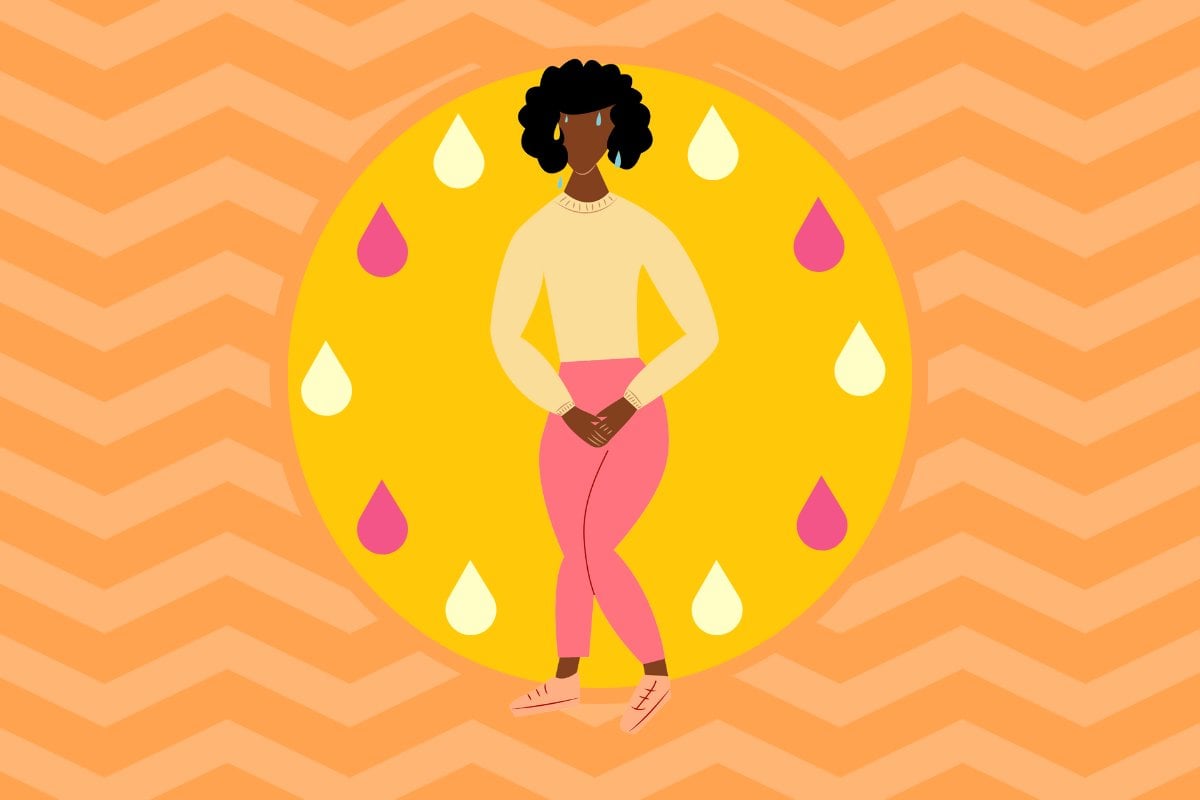
We’re getting much better at talking about the highs and lows of perimenopause, but there are some symptoms we still keep to ourselves – often to our detriment.
At Mamamia’s Very Peri audio series, Co-Founder Mia Freedman delved into one of the peri topics which is still taboo – the effect on the bladder.
Women, mostly mothers, have long been putting up with bladder leakage when they cough, or sneeze, or jump – but it might come as a surprise to know we don’t have to endure this. Dr Charlotte Gooding is a UK-based GP with a strong interest in menopause care, and she told Mia that when it comes to peri and the bladder, we have a way to go.
“Women are really, really used to talking about the hot flushes, the mood changes, the changes in their cycle,” she said in the audio series.
“But the thing that really doesn't get talked about are all the urinary, the bladder symptoms, the vagina or the vulval symptoms, and this whole thing called genitourinary syndrome of menopause. That's where we need more awareness and more understanding,” she said.
“We know from studies that about 70 per cent of women are experiencing symptoms with their bladder, but about 7 per cent of them will come and talk to their doctor about them.”
So, what do women need to be aware of when it comes to menopause and their bladder?
How does peri affect the bladder?
Perimenopause is a time of great fluctuation for our hormones, so we get great highs and lows of oestrogen.
“At times, you can have incredible highs… particularly when you’re ovulating,” Dr. Gooding explains.
“But you’re not always ovulating in perimenopause, so you can get real dips… In those dips, when there are periods of low oestrogen, that’s when it can affect the tissues of the vagina, the bladder, the pelvic floor, and also the vaginal area,” she continues.
“We're talking about the effects of lack of oestrogen on all those tissues, because all those tissues are absolutely rich in oestrogen receptors, and they need oestrogen to function well.”
What does the lack of oestrogen mean?
Because these parts need oestrogen to function well, a lower period of hormone fluctuation mean you might experience things like “vaginal dryness, soreness of the vagina, painful sex, and then in the bladder, you get the weakness of the pelvic floor, so you’re more likely to develop things like prolapse,” Dr. Gooding tells us.
“The pelvic floor is basically like a big sling,” she says. “It just holds up all the pelvic contents… and there are holes in it for urine, the tube that takes the urine from the bladder to the outside to go through your vagina goes through that pelvic floor.”
“So, it’s really important in controlling the release of all those things. When you’re jumping around and there’s pressure building up above the pelvic floor, if there’s not enough structure there to hold that urine in, then it can leak because the pressure is less on the other side,” she explains.
“But the problem is that women just seem to be thinking that this is normal.”
Post continues after video.
How can we train the bladder for perimenopause?
While things like hormone replacement therapy can be helpful when it comes to the effects of peri on the bladder, Dr. Gooding’s first recommendation is pelvic floor exercises. The problem is, they’re much harder than you might think.
“I see women all the time who say to me, I've been doing kegels for years… but it's not helping most of those women, and we know probably about 60 per cent of those women aren't doing them effectively,” Dr. Gooding shares.
“If you think about your bottom, and you think about trying to keep it holding some wind, that's the first thing to do,” she explains.
“Then slowly moving that feeling forward to squeeze the muscles around the entrance to the vaginal canal, and then lastly, think about squeezing in that urethra,” she continues.
“Quite an old-fashioned thing to say is to practice doing it on the toilet, to try and hold in a way… that's not the best way to do it, because that can then cause lots of problems with people over tightening their pelvic floor, and then not being able to release properly.”
 Image: Mamamia.
Image: Mamamia.
Is there anything else we can do?
Dr. Gooding suggests all women should see a pelvic floor physiotherapist.
“It's difficult because there isn't always access to those. But if you can get access to them, it will probably be the best money you’ve ever spent,” she says.
“The other [thing] is that they can give you some feedback as well on how you're doing so you can give yourself feedback on whether you're doing it properly,” she adds.
The Very Peri audio series is your all-in-one survival guide for getting through perimenopause. With 10 topics covering everything from science and symptoms to solutions and support. Everything you need to know to take on peri with confidence. Listen Now.
Feature image: Mamamia.
Are you actively taking steps to improve your health and general wellbeing? Take our survey now to go in the running to win a $50 gift voucher.


